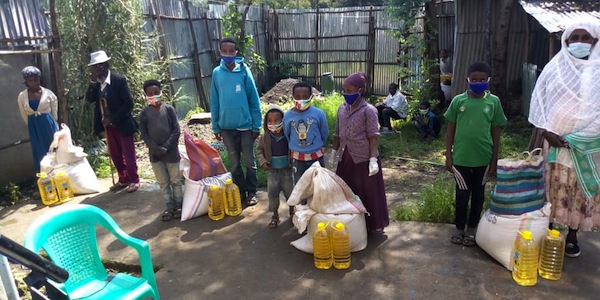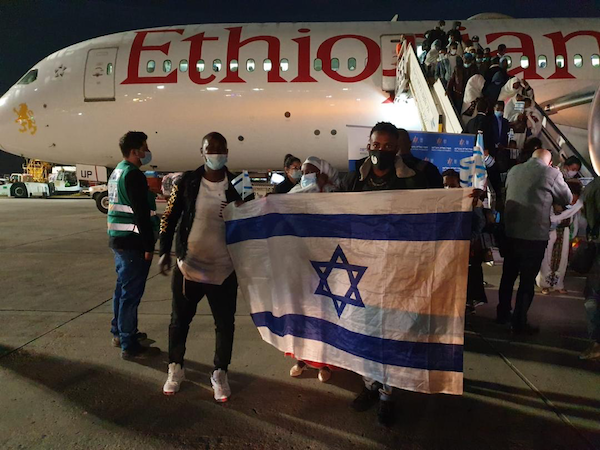Israel’s Operation Tzur Israel, bringing olim from Ethiopia to Israel, began Dec. 3. (photo by Kassaw Molla)
It’s been almost 40 years since Israel coordinated the first airlift of Ethiopian Jews to Israel in 1984. The Beta Israel people, a citizenry of more than 100,000 at the time, were facing starvation in the midst of Ethiopia’s civil war. By the end of Operation Moses, some seven weeks and 30 clandestine flights later, more than 8,000 men, women and children had been airlifted to Israel. Since that time, Israel has rescued more than 30,000 Beta Israel from northern and central Ethiopia.
The impetus for saving Ethiopia’s fractured and often-persecuted Jewish populations goes back to 1921. Rabbi Abraham Isaac Kook, the then-Ashkenazi chief rabbi of British Mandatory Palestine, made an appeal for Jews to rescue the “holy souls of the House of Israel” from “extinction and contamination” in Ethiopia. His urging would be repeated by numerous other rabbis, including a former Sephardi chief rabbi, the late Ovadia Yosef, who, five decades later, declared the population eligible for aliyah to Israel. Nonetheless, there are thousands of Ethiopian families still waiting for their turn to move to the Jewish homeland.
Descendants of Beta Israel
The Jewish enclaves of Gondar City and the Ethiopian capital of Addis Ababa are home to the descendants of those first refugees of the 1980s and 1990s: grandchildren and great-grandchildren, fathers, mothers and children who were born while their parents waited for Israel to fulfil its stated promise to provide a new home. Their primitive living conditions, say aid workers, are often the product of circumstance. In a 2014 interview, Rabbi Sybil Sheridan (now Romain), a co-founder of the aid organization Meketa, told me that the Beta Israel moved to Gondar City from their ancestral farmlands decades ago due to persecution, with the implicit understanding that their next home would be in Israel.
“They gave up their things, they gave up their jobs, they left thinking they would actually be on the next plane,” Sheridan said. For many, those years of waiting for the next plane have resulted in a week-to-week existence, hinged on the assurances of a future that will reunite them with their now-Israeli families.
In 2003, the Israeli government announced that 20,000 Jews would be allowed to move to Israel, but that plan was later dropped when the Ethiopian government objected to the mass emigration. In 2015, when it became evident that Jewish populations were still at risk from persecution, the Knesset declared it would rescue 9,000 Ethiopian Jews, and would complete the airlifts by 2020. Fewer than 1,000 individuals have been admitted during that time.
In October 2020, Prime Minister Binyamin Netanyahu announced that 2,000 olim would be airlifted to Israel by the end of 2020. The deadline for Operation Tzur Israel (Rock of Israel) has been extended to the end of January 2021, and is gradually being fulfilled. Last month, roughly 700 olim arrived from Gondar and Addis Ababa. Another two airlifts this month have brought the total to roughly 1,500.

Family members and aid groups in both countries say the 2,000-person limit is not enough. Those waiting in Israel to see their relatives say they are worried for their families’ safety with the risk of civil war and the coronavirus pandemic. Aid organizations argue that the country’s economic shutdown in March is still causing widespread unemployment. While Meketa and Struggle to Save Ethiopian Jewry (SSEJ), two aid groups that work to support the communities, have been shipping in food to the community synagogues, they warn that families are still at risk from famine.
Avi Bram, a trustee for Meketa, said conditions in Gondar are worrisome. “The community is in a very bad situation. Many, not all, but many are in a very, very poor and unsettled standard of living, especially now because of the pandemic.”
Bram said the original mandate of Meketa, which was established in 2013, was to reinforce independence for the community through training, conversational Hebrew classes and small business micro-loans. It was never designed to be a supplemental food program. But the aid is critical at this time. “It fills a humanitarian need,” he said.
SSEJ representative Jeremy Feit said the organization does what it can to support impoverished members of the Addis Ababa community. It arranges medical assistance for children under 5 and seniors, and hot meals for malnourished children and pregnant and nursing mothers.
“The end goal of the work is to limit needless suffering and deaths, while urging Israel to evaluate their claims and allow those eligible to make aliyah as soon as possible,” said Feit.

Mengistu (no last name given), who lives in Ethiopia and has relatives in Israel from a previous aliyah, said the communities are facing increasing danger. “On one side, there’s coronavirus,” said Mengistu. On [another] side there’s the war,” coupled with endemic unemployment and famine.
According to Mengistu, the changing criteria for airlifts are only inciting more stress at home.
“[They] said they would bring 2,000 people at the end of this year,” Mengistu said. “We don’t know if they applied their decision [because] every time they decide [on a quota], they change it.
“So, who are they going to bring? Are they going to bring children? Are they going to [separate] brothers and sisters and leave [some] with their parents? Two thousand people, it’s nothing,” Mengistu said, “compared to the [actual number of] the people still in Ethiopia.”
A stalwart proponent
In May of last year, Pnina Tamano-Shata was appointed minister of absorption and immigration by the Likud-Blue and White coalition. The 38-year-old Ethiopian-born Israeli came with life experiences that made her an ideal candidate for the position. She and her family had immigrated during the 1980s rescue Operation Moses, during which an estimated 4,000 refugees died en route. She knows firsthand the conditions that today’s Ethiopian Jewish communities are forced to endure while they wait for aliyah.
She also isn’t bashful in her support for immigrant rights or services. In October, she negotiated an agreement with the Israeli nonprofit Shavei Israel to airlift approximately 700 Bnei Menashe Jews from North India. As part of the agreement, Shavei Israel would cover all transportation costs. The new immigrants will quarantine at a moshav before settling into their new homes and reuniting with their families.

As well, she has put forth a vision and a budget for how to finally resolve the humanitarian crisis in Ethiopia.
In August, Tamano-Shata proposed a plan that would allow, in her words, for Israel to “close the camps” in Gondar and Addis Ababa. Approximately 4,000 of 8,000 olim would be airlifted to Israel by year-end and the rest would follow by 2023. The NIS 1.3 billion ($380 million US at the time) proposal received support from all sides but was never adopted. The Netanyahu government later endorsed a limit of 2,000 by Dec. 31, with assurances of more immigrants at a later date.
Still, Tamano-Shata says she is committed to seeing the aliyah to its end. “[To] my dismay, we were unable to approve the national budget which was supposed to include the outline for the aliyah of those remaining in Ethiopia,” Tamano-Shata told the Jewish Independent in a recent email interview. “However, this does not prevent me from continuing to push for a comprehensive solution for this issue.”
To Mengistu, like many in Ethiopia’s Jewish enclaves, Tamano-Shata’s words are a hopeful sign. “Because now the help for the aliyah is Pnina,” said Mengistu. “She’s one of us. So maybe she will understand the situation and the [reason for] the protests [in Israel.] Maybe things will change.”
With Israel now set to face a fourth election in just two years, Tamano-Shata’s future as the next minister of absorption and immigration is yet to be determined, but her motivation to see the end of what is arguably Israel’s greatest humanitarian crisis remains firm. In 2016, the then-new minister was recognized by humanitarian activist Martin Luther King III for her efforts to establish better protections for Ethiopian immigrants in Israel. Last year, she toured the Addis Ababa enclave and handed out baskets of food to residents. She said she is committed to the rights of Israel’s olim, “despite the policies of lockdowns, shutting of flights and closing of the skies that exists in many countries due to COVID-19.”
At this point, all eyes are on Tamano-Shata. Few doubt that she will meet her stated commitment of 2,000 olim by Jan. 31. But can she, as well, engender better trust between Israel and those waiting for aliyah?
In a recent interview for the podcast One Jewish Family, Ambanesh Biru, former chair of the Gondar Jewish community, summarized the views of a hopeful community that knows its safety may rest in the Israeli government’s understanding of their predicament.
Don’t forget about the Ethiopian Jewish community, said Biru, “especially those [anticipating] aliyah. Because all of the Jews in Gondar and Addis Ababa came from villages expecting they would be going to Israel right away, not to live in Gondar [for the rest of their lives]. So, if anybody comes and talks about aliyah from Israel, please do your best [to follow through].”
Readers can learn more about the Gondar and Addis Ababa communities at meketa.org.uk, ssej.org and jewishagency.org/ethiopian-aliyah-explained.
Jan Lee’s articles and blog posts have been published in B’nai B’rith Magazine, Voices of Conservative and Masorti Judaism, Times of Israel, as well as a number of business, environmental and travel publications. Her blog can be found at multiculturaljew.polestarpassages.com.

